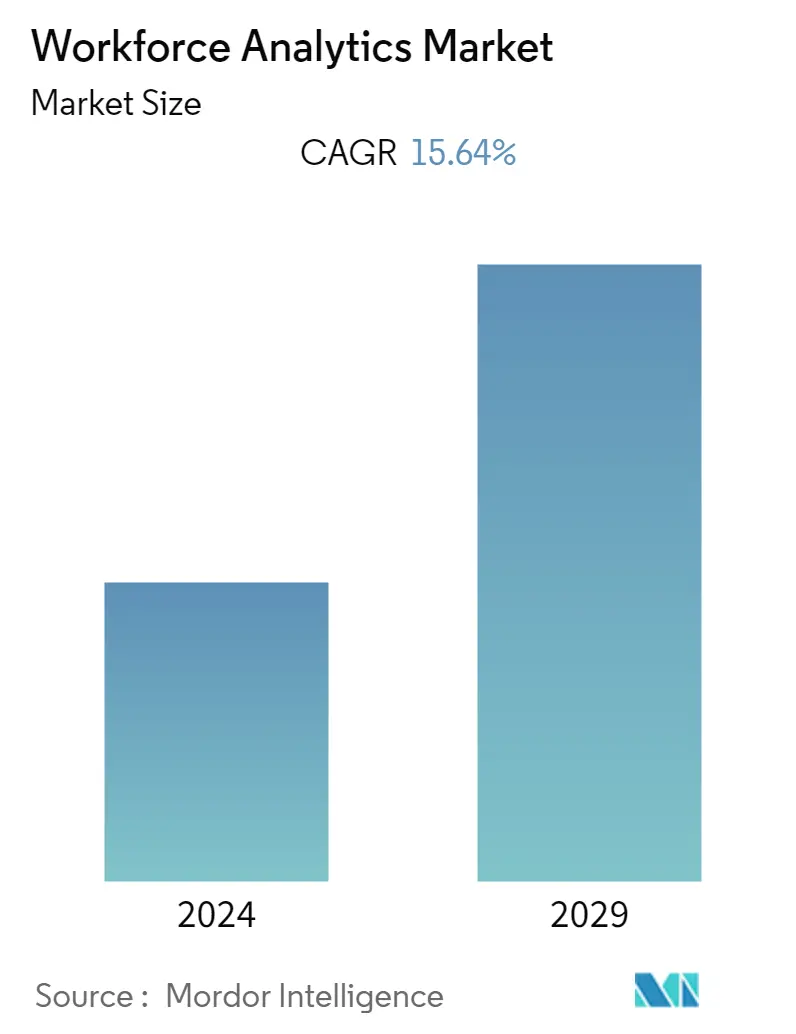Market Size of Workforce Analytics Industry

| Study Period | 2021 - 2029 |
| Base Year For Estimation | 2023 |
| CAGR | 15.64 % |
| Fastest Growing Market | Asia Pacific |
| Largest Market | North America |
| Market Concentration | Low |
Major Players
*Disclaimer: Major Players sorted in no particular order |
Workforce Analytics Market Analysis
The workforce analytics market is expected to register a CAGR of 15.64% over the forecast period. According to the Information Services Group, 58% of enterprises indicated that HR SaaS technology solutions improve the employer user experience globally. This creates a positive impact on the market globally.
- Workforce analytics is used to study the behavior of employees and people data using analyzing people data to make better workforce decisions. This helps increase the productivity of the existing employees instead of hiring additional staff and improves the selection criteria.
- Predictive workforce analytics is one of the critical subtypes of workforce analytics. To forecast, utilizing past data refers to performing workforce analytics to create forecasts. Machine learning and data mining are the primary statistical models employed in this workforce analytics. Many firms use predictive workforce analytics to enhance the employee experience and streamline processes. Regression analysis, pattern matching, multivariate statistics, and other techniques are frequently used in this process to help businesses predict what is likely to occur in the future in terms of risks and talent outcomes.
- In this globalized world, the organization requires flexibility, speed, innovation, and talent to differentiate itself from other firms. It has let employees focus on workforce strategy and employee investment to support business growth and objectives. For instance, Mindtree used HR analytics tools in turnover modeling, risk assessment, management profiles, and productivity indexing. HR analytics tools have helped them predict employee turnover for the subsequent 90 days and enabled them to create usable insights from data analyses used in the forecasting model for the hiring teams.
- However, the lack of product information and the high cost of deployment are a few factors restraining the market from growing in the forecast period.
Workforce Analytics Industry Segmentation
Human capital is an asset for any organization, and to study the people data and gather the data internally helps in increased productivity, increased employee satisfaction, and a low employee turnover rate. With the advancements in technology and an increase in global trade, the dynamic change in the workforce has made it necessary for management to utilize workforce analytics to better optimize customer needs and the employee workforce.
The Workforce Analytics Market is Segmented by Component Type (Solutions (Talent Acquisition and Development Optimization Services and Pay Roll and Monitoring) and Services (Professional Services and Managed Services)), by Deployment Type (On-cloud and On-premises), by Organization Size (Small- and Medium-Sized Enterprises and Large Enterprises), by End User ( BFSI, Manufacturing, IT & Telecom, Healthcare, and Retail), and by Geography (North America, Europe, Asia-Pacific, Latin America, and Middle East and Africa).
The market sizes and forecasts are provided in terms of value (USD million) for all the above segments.
| By Component Type | ||||
| ||||
|
| By Deployment Type | |
| On-cloud | |
| On-premises |
| By Organization Size | |
| Small- and Medium-Sized Enterprises | |
| Large Enterprises |
| By End-user Industry | |
| Banking, Financial Services, and Insurance (BFSI) | |
| Manufacturing | |
| IT & Telecom | |
| Healthcare | |
| Retail | |
| Other End-user Industries |
| Geography | |
| North America | |
| Europe | |
| Asia-Pacific | |
| Latin America | |
| Middle East and Africa |
Workforce Analytics Market Size Summary
The workforce analytics market is poised for significant growth, driven by the increasing adoption of HR SaaS technology solutions that enhance the employer user experience. This market segment focuses on analyzing employee behavior and data to make informed workforce decisions, thereby boosting productivity and improving selection criteria. Predictive workforce analytics, a crucial subtype, utilizes machine learning and data mining to forecast future workforce trends, helping organizations enhance employee experiences and streamline processes. The demand for real-time talent decisions and the need to monitor employee performance are becoming paramount as organizations strive to differentiate themselves in a competitive landscape. Companies like Mindtree, Tata Consultancy Services, and Infosys are leveraging these analytics to predict employee turnover and monitor performance, which in turn supports business growth and strategic objectives.
The Asia-Pacific region is expected to experience the fastest growth in the workforce analytics market, driven by a shift towards employee-centric organizations and government initiatives like Startup India. The region's companies are increasingly adopting workforce analytics to gain competitive advantages and make data-driven HR decisions. In countries like China, the focus on managerial efficiency and the integration of data analytics into economic models are further propelling market growth. The competitive landscape is marked by the presence of major players such as IBM Corporation, Oracle Corporation, and Accenture, who are continuously innovating to meet the rising demand for advanced talent and recruiting solutions. Recent developments, such as IBM's new software to break down data silos and Capgemini's acquisition of Braincourt, highlight the ongoing efforts to enhance data and analytics capabilities across various industries.
Workforce Analytics Market Size - Table of Contents
-
1. MARKET DYNAMICS
-
1.1 Market Overview
-
1.2 Introduction to Market Drivers and Restraints
-
1.3 Market Drivers
-
1.3.1 Increasing Need to Make a Smarter a Decision About the Talent
-
1.3.2 Increasing Data in HR Departments related to Pay rolls, Recruitment
-
-
1.4 Market Restraints
-
1.4.1 Lack of Awareness About Workforce Analytics
-
-
1.5 Industry Value Chain Analysis
-
1.6 Industry Attractiveness - Porter's Five Force Analysis
-
1.6.1 Threat of New Entrants
-
1.6.2 Bargaining Power of Buyers/Consumers
-
1.6.3 Bargaining Power of Suppliers
-
1.6.4 Threat of Substitute Products
-
1.6.5 Intensity of Competitive Rivalry
-
-
-
2. MARKET SEGMENTATION
-
2.1 By Component Type
-
2.1.1 Solutions
-
2.1.1.1 Talent Acquisition and Development Optimization Services
-
2.1.1.2 Pay Roll and Monitoring
-
-
2.1.2 Service
-
2.1.2.1 Professional Services
-
2.1.2.2 Managed Services
-
-
-
2.2 By Deployment Type
-
2.2.1 On-cloud
-
2.2.2 On-premises
-
-
2.3 By Organization Size
-
2.3.1 Small- and Medium-Sized Enterprises
-
2.3.2 Large Enterprises
-
-
2.4 By End-user Industry
-
2.4.1 Banking, Financial Services, and Insurance (BFSI)
-
2.4.2 Manufacturing
-
2.4.3 IT & Telecom
-
2.4.4 Healthcare
-
2.4.5 Retail
-
2.4.6 Other End-user Industries
-
-
2.5 Geography
-
2.5.1 North America
-
2.5.2 Europe
-
2.5.3 Asia-Pacific
-
2.5.4 Latin America
-
2.5.5 Middle East and Africa
-
-
Workforce Analytics Market Size FAQs
What is the current Workforce Analytics Market size?
The Workforce Analytics Market is projected to register a CAGR of 15.64% during the forecast period (2024-2029)
Who are the key players in Workforce Analytics Market?
IBM Corporation, Oracle Corporation, Accenture plc, Capgemini SE and Tableau Software are the major companies operating in the Workforce Analytics Market.

